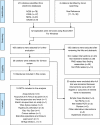Effects and treatment methods of acupuncture and herbal medicine for premenstrual syndrome/premenstrual dysphoric disorder: systematic review
- PMID: 24410911
- PMCID: PMC3898234
- DOI: 10.1186/1472-6882-14-11
Effects and treatment methods of acupuncture and herbal medicine for premenstrual syndrome/premenstrual dysphoric disorder: systematic review
Abstract
Background: During their reproductive years about 10% of women experience some kind of symptoms before menstruation (PMS) in a degree that affects their quality of life (QOL). Acupuncture and herbal medicine has been a recent favorable therapeutic approach. Thus we aimed to review the effects of acupuncture and herbal medicine in the past decade as a preceding research in order to further investigate the most effective Korean Medicine treatment for PMS/PMDD.
Methods: A systematic literature search was conducted using electronic databases on studies published between 2002 and 2012. Our review included randomized controlled clinical trials (RCTs) of acupuncture and herbal medicine for PMS/PMDD. Interventions include acupuncture or herbal medicine. Clinical information including statistical tests was extracted from the articles and summarized in tabular form or in the text. Study outcomes were presented as the rate of improvement (%) and/or end-of-treatment scores.
Results: The search yielded 19 studies. In screening the RCTs, 8 studies in acupuncture and 11 studies in herbal medicine that matched the criteria were identified. Different acupuncture techniques including traditional acupuncture, hand acupuncture and moxibustion, and traditional acupuncture technique with auricular points, have been selected for analysis. In herbal medicine, studies on Vitex Agnus castus, Hypericum perforatum, Xiao yao san, Elsholtzia splendens, Cirsium japonicum, and Gingko biloba L. were identified. Experimental groups with Acupuncture and herbal medicine treatment (all herbal medicine except Cirsium japonicum) had significantly improved results regarding PMS/PMDD.
Conclusions: Limited evidence supports the efficacy of alternative medicinal interventions such as acupuncture and herbal medicine in controlling premenstrual syndrome and premenstrual dysphoric disorder. Acupuncture and herbal medicine treatments for premenstrual syndrome and premenstrual dysphoric disorder showed a 50% or better reduction of symptoms compared to the initial state. In both acupuncture and herbal medical interventions, there have been no serious adverse events reported, proving the safety of the interventions while most of the interventions provided over 50% relief of symptoms associated with PMS/PMDD. Stricter diagnostic criteria may have excluded many participants from some studies. Also, depending on the severity of symptoms, the rate of improvement in the outcomes of the studies may have greatly differed.
Figures
Similar articles
-
Non-contraceptive oestrogen-containing preparations for controlling symptoms of premenstrual syndrome.Cochrane Database Syst Rev. 2017 Mar 3;3(3):CD010503. doi: 10.1002/14651858.CD010503.pub2. Cochrane Database Syst Rev. 2017. PMID: 28257559 Free PMC article.
-
Vitex agnus castus for premenstrual syndrome and premenstrual dysphoric disorder: a systematic review.Arch Womens Ment Health. 2017 Dec;20(6):713-719. doi: 10.1007/s00737-017-0791-0. Epub 2017 Oct 23. Arch Womens Ment Health. 2017. PMID: 29063202
-
Gonadotropin-releasing hormone (GnRH) analogues for premenstrual syndrome (PMS).Cochrane Database Syst Rev. 2025 Jun 10;6(6):CD011330. doi: 10.1002/14651858.CD011330.pub2. Cochrane Database Syst Rev. 2025. PMID: 40492482 Review.
-
The treatment of premenstrual syndrome with preparations of Vitex agnus castus: a systematic review and meta-analysis.Am J Obstet Gynecol. 2017 Aug;217(2):150-166. doi: 10.1016/j.ajog.2017.02.028. Epub 2017 Feb 22. Am J Obstet Gynecol. 2017. PMID: 28237870
-
Systemic pharmacological treatments for chronic plaque psoriasis: a network meta-analysis.Cochrane Database Syst Rev. 2021 Apr 19;4(4):CD011535. doi: 10.1002/14651858.CD011535.pub4. Cochrane Database Syst Rev. 2021. Update in: Cochrane Database Syst Rev. 2022 May 23;5:CD011535. doi: 10.1002/14651858.CD011535.pub5. PMID: 33871055 Free PMC article. Updated.
Cited by
-
Altered fractional amplitude of low-frequency fluctuation in women with premenstrual syndrome via acupuncture at Sanyinjiao (SP6).Ann Gen Psychiatry. 2021 May 8;20(1):29. doi: 10.1186/s12991-021-00349-z. Ann Gen Psychiatry. 2021. PMID: 33964936 Free PMC article.
-
Using Quantitative Hormonal Fertility Monitors to Evaluate the Luteal Phase: Proof of Concept Case Study.Medicina (Kaunas). 2023 Jan 10;59(1):140. doi: 10.3390/medicina59010140. Medicina (Kaunas). 2023. PMID: 36676764 Free PMC article.
-
Acupuncture-Neuroimaging Research Trends over Past Two Decades: A Bibliometric Analysis.Chin J Integr Med. 2023 Mar;29(3):258-267. doi: 10.1007/s11655-022-3672-y. Epub 2022 May 4. Chin J Integr Med. 2023. PMID: 35508861 Review.
-
Acupuncture and acupressure for premenstrual syndrome.Cochrane Database Syst Rev. 2018 Aug 14;8(8):CD005290. doi: 10.1002/14651858.CD005290.pub2. Cochrane Database Syst Rev. 2018. PMID: 30105749 Free PMC article.
-
Efficacy of Chamomile in the Treatment of Premenstrual Syndrome: A Systematic Review.J Pharmacopuncture. 2019 Dec;22(4):204-209. doi: 10.3831/KPI.2019.22.028. Epub 2019 Dec 31. J Pharmacopuncture. 2019. PMID: 31970017 Free PMC article. Review.
References
-
- DeMonico SO, Brown CS, Ling FW. Premenstrual syndrome. Curr Opin Obstet Gynecol. 1994;6:499–502. - PubMed
-
- Choi DS. Premenstrual syndrome. J Women Med. 2009;2(4):141–146.
Publication types
MeSH terms
LinkOut - more resources
Full Text Sources
Other Literature Sources
Medical
Miscellaneous


